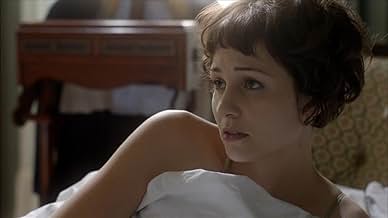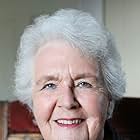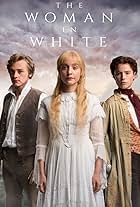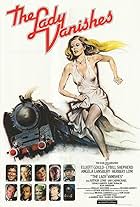IMDb RATING
6.1/10
2.6K
YOUR RATING
While traveling by train, a young socialite is befriended by a charming yet enigmatic older woman. However, when the woman disappears, the other passengers deny she ever existed.While traveling by train, a young socialite is befriended by a charming yet enigmatic older woman. However, when the woman disappears, the other passengers deny she ever existed.While traveling by train, a young socialite is befriended by a charming yet enigmatic older woman. However, when the woman disappears, the other passengers deny she ever existed.
Paolo Antonio Simioni
- Border Guard
- (as Paolo Antonio)
Marta Bolfan
- Blonde Woman
- (as Marta Bolfan Ugljen)
Vilmos Cservenák
- Ticket Master
- (as Vilmos Csevernák)
- Director
- Writers
- All cast & crew
- Production, box office & more at IMDbPro
Storyline
Did you know
- TriviaDespite being set in Croatia, Italy and England, the film was entirely shot in Hungary.
- Crazy creditsIf you look carefully, there are red letters in some of the crew's names. In order, they spell out "The Wheel Spins," the novel by Ethel Lena White on which this movie is based.
- ConnectionsVersion of The Lady Vanishes (1938)
Featured review
For comparison, I have always hankered after another, more faithful adaptation of Strangers on a Train. The Highsmith original is on a completely different psychological plane to Hitchcock's superb adaptation, which plays with the banality of evil theme but adds ticking, suspenseful timebombs and a hero who may have moments of weakness but triumphs in the end.
The 2013 version of The Lady Vanishes will have to do instead. It is NOT a remake nor a version of nor even based on the Hitchcock film. Far from it. Bemoaning the absence of Charters and Caldicott misses the point entirely. This film is a much straighter adaptation of Hitchcock's original source material, The Wheel Spins by Ethel Lina White.
Even if this new production were rubbish, as a close adaptation of the original source, it would still offer worthwhile study by providing an illustration of how much craft the master added to create one of the best films of the 1930's. Let's face it, no one has read the novel. Hitch turns an essay in nervousness about more trouble in the Balkans into an appeasement era allegory of the difficulty of shaking people out of an apathetic response to tyranny and the virtues of resistance, all dressed in beautifully tailored cinematic clothes that will last forever.
Diarmuid Lawrence's The Lady Vanishes, however, is very far from rubbish. It has a powerful, beautifully judged central performance from an actress who, unlike Cybill Shepherd in what WAS a remake in 1979, is in the same class as Margaret Lockwood.
In the initial scenes she is part of a group of what the newspapers called Bright Young Things but Evelyn Waugh called Vile Bodies. She is able to stand out from her awful, shallow friends, however, with suggestions of an open mind and a wider view of the world. Without falling into clichés, Middleton distances herself in an afternoon and evening of misbehaviour then separates herself entirely by staying behind when her friends leave.
This turns out to be an empty gesture. After a failed attempt at adventure, she immediately returns to type missing her friends, refusing offers of company, throwing money around at the locals and falling back into the character of a rude, spoilt mademoiselle, shorn of her comforts.
This sets up the irony of her behaviour on the train when she finally discovers what it is that is truly different about her. However now, for a variety of reasons, people who can see the difference can't acknowledge it and people who can't see the difference misinterpret her. The only person who has understood her correctly has vanished. Lawrence's version holds on to this subtle psychological setup much longer than Hitchcock's. Those who think she's hysterical plot to sedate her. Those who know she isn't, hide themselves.
Middleton's work is a real treat. The rest of the cast may not have enough to work with (one of the reasons why Hitchcock conducted a major rewrite). And instead of a graceful denouement, the action does rather hit the buffers at the end of the line. Very nice lwork in the last scene, though, more reminiscent of North by North West.
However, despite a few shortcomings, this is a neat piece of period drama in its own right and casts a bright and valuable sidelight on Hitchcock's work as an adapter.
No one should put off by misguided criticism that it fails to live up to Lockwood and Redgrave. Unlike the 1979 rehash, it has earned its place on the shelf next to the Hitchcock version of the same novel.
The 2013 version of The Lady Vanishes will have to do instead. It is NOT a remake nor a version of nor even based on the Hitchcock film. Far from it. Bemoaning the absence of Charters and Caldicott misses the point entirely. This film is a much straighter adaptation of Hitchcock's original source material, The Wheel Spins by Ethel Lina White.
Even if this new production were rubbish, as a close adaptation of the original source, it would still offer worthwhile study by providing an illustration of how much craft the master added to create one of the best films of the 1930's. Let's face it, no one has read the novel. Hitch turns an essay in nervousness about more trouble in the Balkans into an appeasement era allegory of the difficulty of shaking people out of an apathetic response to tyranny and the virtues of resistance, all dressed in beautifully tailored cinematic clothes that will last forever.
Diarmuid Lawrence's The Lady Vanishes, however, is very far from rubbish. It has a powerful, beautifully judged central performance from an actress who, unlike Cybill Shepherd in what WAS a remake in 1979, is in the same class as Margaret Lockwood.
In the initial scenes she is part of a group of what the newspapers called Bright Young Things but Evelyn Waugh called Vile Bodies. She is able to stand out from her awful, shallow friends, however, with suggestions of an open mind and a wider view of the world. Without falling into clichés, Middleton distances herself in an afternoon and evening of misbehaviour then separates herself entirely by staying behind when her friends leave.
This turns out to be an empty gesture. After a failed attempt at adventure, she immediately returns to type missing her friends, refusing offers of company, throwing money around at the locals and falling back into the character of a rude, spoilt mademoiselle, shorn of her comforts.
This sets up the irony of her behaviour on the train when she finally discovers what it is that is truly different about her. However now, for a variety of reasons, people who can see the difference can't acknowledge it and people who can't see the difference misinterpret her. The only person who has understood her correctly has vanished. Lawrence's version holds on to this subtle psychological setup much longer than Hitchcock's. Those who think she's hysterical plot to sedate her. Those who know she isn't, hide themselves.
Middleton's work is a real treat. The rest of the cast may not have enough to work with (one of the reasons why Hitchcock conducted a major rewrite). And instead of a graceful denouement, the action does rather hit the buffers at the end of the line. Very nice lwork in the last scene, though, more reminiscent of North by North West.
However, despite a few shortcomings, this is a neat piece of period drama in its own right and casts a bright and valuable sidelight on Hitchcock's work as an adapter.
No one should put off by misguided criticism that it fails to live up to Lockwood and Redgrave. Unlike the 1979 rehash, it has earned its place on the shelf next to the Hitchcock version of the same novel.
Details
- Release date
- Country of origin
- Official sites
- Language
- Also known as
- Леді зникає
- Filming locations
- Budapest, Hungary(Keleti Railway Station)
- Production companies
- See more company credits at IMDbPro
- Runtime1 hour 26 minutes
- Color
- Sound mix
- Aspect ratio
- 1.85 : 1
- 16:9 HD
Contribute to this page
Suggest an edit or add missing content






























